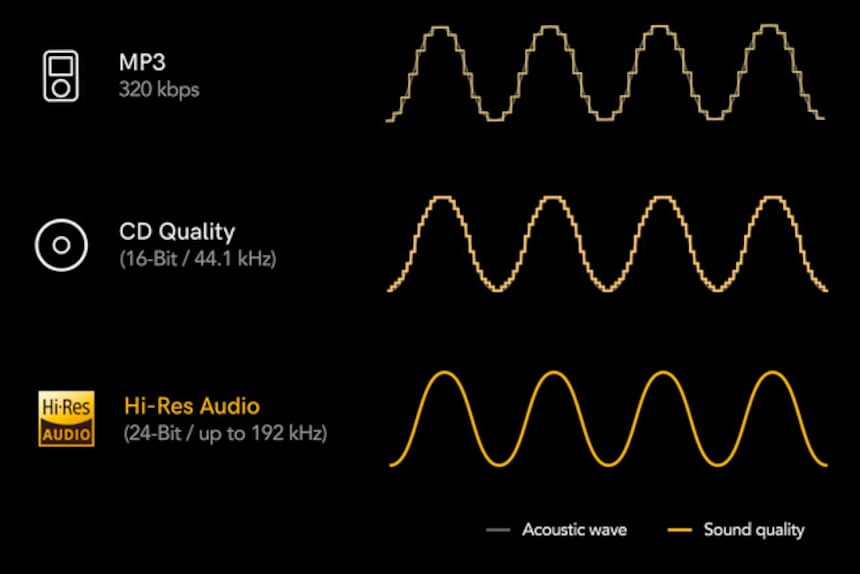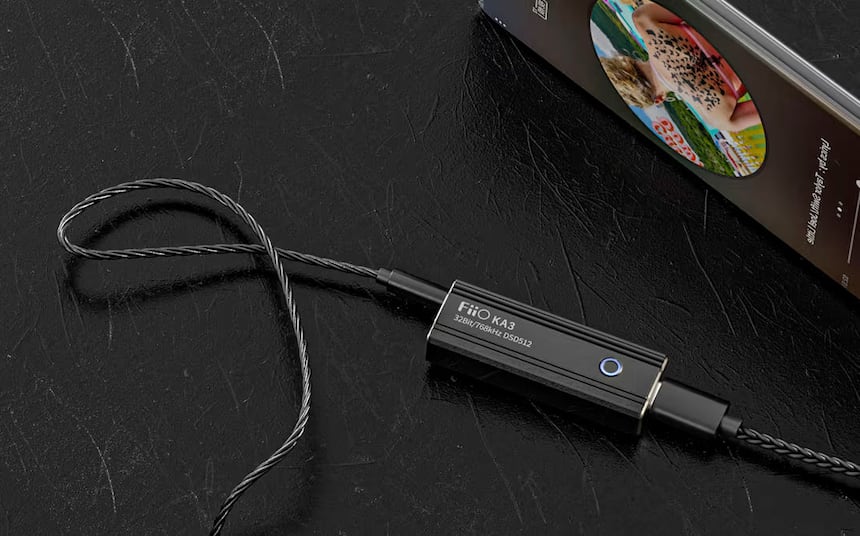Music as it was Originally Recorded
The aim of Hi-Res (High-Resolution) music is to bring us even closer to the artists, so we might be able to hear the music as they recorded it in the studio. This was never really possible during the era of physical music formats. There simply wasn’t enough room to record the finest details and realistically portray such an extended dynamic range.
As with older media formats, the compact disc (CD) required a certain amount of compromise to adapt to the average capabilities of the human ear. Information was left out despite existing on the “master tapes”, i.e., the original studio recordings. With High-Resolution, record companies have taken these tapes and created new file formats which guarantee access to all the information captured by the microphones.

You’ve probably already seen the image above which illustrates the advantages of High-Resolution diagrammatically. Without going too far into the technicalities (there’s already exhaustive literature on this subject), High-Resolution increases definition, dynamics, and bandwidth. We achieve a reduction in background noise and an extension of the frequency band to make room for more information. While listening, all these little technical subtleties make it possible to pick up more details in the reproduction by bringing improvements to the separation, sound stage, and dynamics...
When high resolution is available, it would be a waste not to make the most of it. It is the most respectful format for original music. This is why, since its launch in 2007, Qobuz has decided to stand out from the competition by offering the largest existing catalogue of dematerialised high-resolution music.
From MP3 to Ultra-High Resolution
High-Resolution music is a relatively new innovation. For a long time, we made do with CD quality, which already had many advantages in terms of listening comfort. However, it has followed a path that goes back a long way. Because, whether it’s for streaming or in file format, the starting point for dematerialised music is MP3.
Analog Sources
Before the advent of digital in the mid-1980s, music was listened to using analog media sources: vinyl and audio cassettes. These formats offered a lower sound quality than the recording equipment was capable of picking up. Bandwidth was shortened at low and high frequencies; the dynamics were poorly developed and the background noise significant.
CD Quality
The CD was designed to satisfy the capabilities of the human ear in terms of frequency perception and dynamic scale (the difference between the quietest sounds and the loudest sounds). It was thus possible to enjoy music as it had been intended by artists and sound engineers. As a reminder, the digital signal of a CD had a bit rate of under 16 bits and a sample rate of 44.1 kHz.
Digital Audio Files
At the end of the 90s computer-readable music formats appeared. To respect the constraints of space and transfer capabilities via the Internet, the songs were seriously degraded through lossy data compression. It was almost as if we were going back several decades with a quality inferior to vinyl records.
High Resolution
With the help of technological developments, digital files have been able to gain in quality to exceed that offered by the CD. Lossless compression formats (such as FLAC) opened the door to high resolution. Not everyone agrees on the level from which we can speak of High-Resolution. For some, 48 kHz and 24 bits is enough. For others, High-Resolution does not exist below 96 kHz and 24 bits. Here at Qobuz, High-Resolution goes up to 192 kHz and 24 bits.
Ultra-High Resolution
It is possible to go even further than the 192/24 ratio. Beyond that, you need quality equipment and a sharp ear. Any improvements will relate to an increase in bandwidth and a multiplication of the detail. The most efficient DACs are able to play files up to 768 kHz and under 32 bits. As for DSD, a variant in the field of Hi-Res files, it is possible to go up to DSD1024, but few devices are actually able to read them. Not to mention that at this level of definition, a single audio file can be up to 1 GB.
How to Enjoy High-Resolution on Your Hi-Fi System
Only one device in your HiFi set needs to be compatible with high resolution for the whole system to work. There are no High-Resolution power amplifiers, speakers, or cables. The only high-resolution element needed is a digital-to-analogue converter, more commonly known as a DAC. Whether stand-alone, integrated into the network player or an amplifier, it guarantees high-resolution music playback and is converted to analogue via the amplifier and speakers.
For a few years now, almost all DACs have been compatible with at least 192/24 high-resolution. However, not all network drives are compatible. This is something to consider before buying. For example, some devices capable of accessing Qobuz are limited to 48/24 or 96/24 playback.
Don’t forget to ensure that high-resolution playback is enabled on your device or app settings. In some cases, the maximum quality is CD quality, even if your Qobuz subscription gives you access to High-Resolution. For example, with a Sonos system, you can go to your Qobuz account and then to the “My external services” menu. With Roon, you have to go to the settings and then to the “Services” menu to modify the overall playback quality.
How to Enjoy High-Resolution on the Go
Accessing High-Resolution music playback outside the home is a bit trickier. First of all, let’s get rid of sticking point number one: Bluetooth. At the moment, this wireless transmission protocol to headphones does not make it possible to reach High-Resolution in 192/24. The best aptX HD and LDAC codecs are well below, applying lossy compression.
The use of a wired headset is therefore necessary. Mobile High-Resolution playback requires the use of a high-performance DAP capable of accessing Qobuz or playing high-quality stored files. It is also possible to use a smartphone to which a USB or Lightning mini-DAC is connected to decode high resolutions.

Remember that the whole point of High-Resolution is in the breadth of bandwidth and the micro-details. Even if you’re equipped with the best mobile configuration, if the surrounding environment is noisy (transport, city background noise etc.), the resulting headphone reproduction will also be noisy and all the benefits of High-Resolution will be lost.
In summary, it is now very easy to take advantage of High-Resolution using your Qobuz subscription. There are many compatible DACs and network players to satisfy a wide range of budgets. Upgrading your HiFi system to High-Resolution has never been easier. As for listening while on the go, products do exist, but you need to pay attention to your environment. As described, only listening in the garden or a very quiet place will allow you to really enjoy high resolution in your headphones.